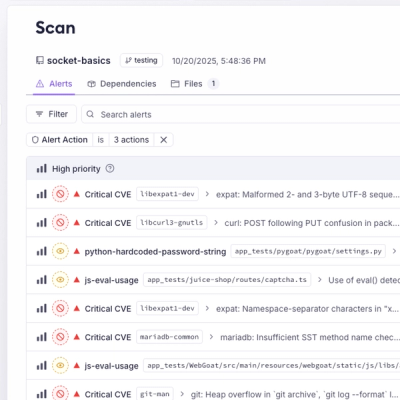
Product
Unify Your Security Stack with Socket Basics
A single platform for static analysis, secrets detection, container scanning, and CVE checks—built on trusted open source tools, ready to run out of the box.
client-sdk-fps
Advanced tools
Developer-friendly & type-safe Typescript SDK specifically catered to leverage *client-sdk-fps* API.
Developer-friendly & type-safe Typescript SDK specifically catered to leverage client-sdk-fps API.
VIDEO ON DEMAND API: Media APIs provides a set of API endpoints that enable developers to manage video and audio content on the FastPix platform. These endpoints are designed for creating, retrieving, updating, and deleting media files, as well as handling metadata and playback settings. This functionality is crucial for any video-centric product or application that serves video on demand (VOD) or audio on demand (AOD) content, allowing developers to programmatically manage their media library.
These endpoints allow developers to automate the process of uploading media, managing playback permissions, and customizing the user experience. With the ability to create media from URLs, upload videos directly from devices, add audio or subtitle tracks, and manage playback IDs, developers can build scalable and flexible VOD solutions. The Media APIs ensure that content is easily accessible, customizable, and ready for distribution to users.
Building a video-on-demand platform: Developers can use these APIs to manage video libraries for streaming services, allowing users to watch content on demand.
Media management for e-learning platforms: Instructors can upload lecture videos, update content metadata, and control playback settings for students using these endpoints.
Adding multiple language tracks to videos: Developers can append additional audio or subtitle tracks to media for a global audience, providing a personalized viewing experience.
[!TIP] To finish publishing your SDK to npm and others you must run your first generation action.
The SDK can be installed with either npm, pnpm, bun or yarn package managers.
npm add <UNSET>
pnpm add <UNSET>
bun add <UNSET>
yarn add <UNSET> zod
# Note that Yarn does not install peer dependencies automatically. You will need
# to install zod as shown above.
[!NOTE] This package is published with CommonJS and ES Modules (ESM) support.
For supported JavaScript runtimes, please consult RUNTIMES.md.
import { ClientSDKFps } from "client-sdk-fps";
const clientSDKFps = new ClientSDKFps({
security: {
username: "",
password: "",
},
});
async function run() {
const result = await clientSDKFps.inputVideo.createMedia({
inputs: [
{
type: "video",
url: "https://static.fastpix.io/sample.mp4",
},
],
metadata: {},
accessPolicy: "public",
});
console.log(result);
}
run();
This SDK supports the following security scheme globally:
| Name | Type | Scheme | Environment Variable |
|---|---|---|---|
usernamepassword | http | HTTP Basic | CLIENTSDKFPS_USERNAMECLIENTSDKFPS_PASSWORD |
You can set the security parameters through the security optional parameter when initializing the SDK client instance. For example:
import { ClientSDKFps } from "client-sdk-fps";
const clientSDKFps = new ClientSDKFps({
security: {
username: "",
password: "",
},
});
async function run() {
const result = await clientSDKFps.inputVideo.createMedia({
inputs: [
{
type: "video",
url: "https://static.fastpix.io/sample.mp4",
},
],
metadata: {},
accessPolicy: "public",
});
console.log(result);
}
run();
All the methods listed above are available as standalone functions. These functions are ideal for use in applications running in the browser, serverless runtimes or other environments where application bundle size is a primary concern. When using a bundler to build your application, all unused functionality will be either excluded from the final bundle or tree-shaken away.
To read more about standalone functions, check FUNCTIONS.md.
drmConfigurationsGetDRMConfiguration - Get list of DRM configuration IDsdrmConfigurationsGetDRMConfigurationById - Get DRM configuration by IDinputVideoCreateMedia - Create media from URLinputVideoDirectUploadVideoMedia - Upload media from deviceinVideoAIFeaturesUpdateMediaChapters - Generate video chaptersinVideoAIFeaturesUpdateMediaModeration - Enable video moderationinVideoAIFeaturesUpdateMediaNamedEntities - Generate named entitiesinVideoAIFeaturesUpdateMediaSummary - Generate video summarymanageVideosAddMediaTrack - Add audio / subtitle trackmanageVideosCancelUpload - Cancel ongoing uploadmanageVideosDeleteMedia - Delete a media by IDmanageVideosDeleteMediaTrack - Delete audio / subtitle trackmanageVideosGenerateSubtitleTrack - Generate track subtitlemanageVideosGetMedia - Get a media by IDmanageVideosGetMediaClips - Get all clips of a mediamanageVideosListLiveClips - Get all clips of a live streammanageVideosListMedia - Get list of all mediamanageVideosListUploads - Get all unused upload URLsmanageVideosRetrieveMediaInputInfo - Get info of media inputsmanageVideosUpdatedMedia - Update a media by IDmanageVideosUpdatedMp4Support - Update the mp4Support of a media by IDmanageVideosUpdatedSourceAccess - Update the source access of a media by IDmanageVideosUpdateMediaTrack - Update audio / subtitle trackplaybackCreateMediaPlaybackId - Create a playback IDplaybackDeleteMediaPlaybackId - Delete a playback IDplaybackGetPlaybackId - Get a playback IDplaylistAddMediaToPlaylist - Add media to a playlist by IDplaylistChangeMediaOrderInPlaylist - Change media order in a playlist by IDplaylistCreateAPlaylist - Create a new playlistplaylistDeleteAPlaylist - Delete a playlist by IDplaylistDeleteMediaFromPlaylist - Delete media in a playlist by IDplaylistGetAllPlaylists - Get all playlistsplaylistGetPlaylistById - Get a playlist by IDplaylistUpdateAPlaylist - Update a playlist by IDSome of the endpoints in this SDK support retries. If you use the SDK without any configuration, it will fall back to the default retry strategy provided by the API. However, the default retry strategy can be overridden on a per-operation basis, or across the entire SDK.
To change the default retry strategy for a single API call, simply provide a retryConfig object to the call:
import { ClientSDKFps } from "client-sdk-fps";
const clientSDKFps = new ClientSDKFps({
security: {
username: "",
password: "",
},
});
async function run() {
const result = await clientSDKFps.inputVideo.createMedia({
inputs: [
{
type: "video",
url: "https://static.fastpix.io/sample.mp4",
},
],
metadata: {},
accessPolicy: "public",
}, {
retries: {
strategy: "backoff",
backoff: {
initialInterval: 1,
maxInterval: 50,
exponent: 1.1,
maxElapsedTime: 100,
},
retryConnectionErrors: false,
},
});
console.log(result);
}
run();
If you'd like to override the default retry strategy for all operations that support retries, you can provide a retryConfig at SDK initialization:
import { ClientSDKFps } from "client-sdk-fps";
const clientSDKFps = new ClientSDKFps({
retryConfig: {
strategy: "backoff",
backoff: {
initialInterval: 1,
maxInterval: 50,
exponent: 1.1,
maxElapsedTime: 100,
},
retryConnectionErrors: false,
},
security: {
username: "",
password: "",
},
});
async function run() {
const result = await clientSDKFps.inputVideo.createMedia({
inputs: [
{
type: "video",
url: "https://static.fastpix.io/sample.mp4",
},
],
metadata: {},
accessPolicy: "public",
});
console.log(result);
}
run();
ClientSDKFpsError is the base class for all HTTP error responses. It has the following properties:
| Property | Type | Description |
|---|---|---|
error.message | string | Error message |
error.statusCode | number | HTTP response status code eg 404 |
error.headers | Headers | HTTP response headers |
error.body | string | HTTP body. Can be empty string if no body is returned. |
error.rawResponse | Response | Raw HTTP response |
error.data$ | Optional. Some errors may contain structured data. See Error Classes. |
import { ClientSDKFps } from "client-sdk-fps";
import * as errors from "client-sdk-fps/models/errors";
const clientSDKFps = new ClientSDKFps({
security: {
username: "",
password: "",
},
});
async function run() {
try {
const result = await clientSDKFps.inputVideo.createMedia({
inputs: [
{
type: "video",
url: "https://static.fastpix.io/sample.mp4",
},
],
metadata: {},
accessPolicy: "public",
});
console.log(result);
} catch (error) {
// The base class for HTTP error responses
if (error instanceof errors.ClientSDKFpsError) {
console.log(error.message);
console.log(error.statusCode);
console.log(error.body);
console.log(error.headers);
// Depending on the method different errors may be thrown
if (error instanceof errors.BadRequestError) {
console.log(error.data$.success); // boolean
console.log(error.data$.error); // models.BadRequestError
}
}
}
}
run();
Primary errors:
ClientSDKFpsError: The base class for HTTP error responses.
Network errors:
ConnectionError: HTTP client was unable to make a request to a server.RequestTimeoutError: HTTP request timed out due to an AbortSignal signal.RequestAbortedError: HTTP request was aborted by the client.InvalidRequestError: Any input used to create a request is invalid.UnexpectedClientError: Unrecognised or unexpected error.Inherit from ClientSDKFpsError:
ValidationErrorResponse: Status code 422. Applicable to 27 of 34 methods.*ForbiddenError: Status code 403. Applicable to 26 of 34 methods.*MediaNotFoundError: Status code 404. Applicable to 17 of 34 methods.*UnauthorizedError: Unauthorized. Status code 401. Applicable to 8 of 34 methods.*InvalidPlaylistIdResponseError: Payload Validation Failed. Status code 422. Applicable to 6 of 34 methods.*BadRequestError: Bad Request. Status code 400. Applicable to 5 of 34 methods.*NotFoundError: Playlist not found. Status code 404. Applicable to 5 of 34 methods.*TrackDuplicateRequestError: Duplicate language name. Status code 400. Applicable to 3 of 34 methods.*MediaOrPlaybackNotFoundError: Status code 404. Applicable to 2 of 34 methods.*DuplicateMp4SupportError: Mp4Support value already exists. Status code 400. Applicable to 1 of 34 methods.*MediaClipNotFoundError: media workspace relation not found. Status code 404. Applicable to 1 of 34 methods.*DuplicateReferenceIdErrorResponse: Displays the result of the request. Status code 409. Applicable to 1 of 34 methods.*ResponseValidationError: Type mismatch between the data returned from the server and the structure expected by the SDK. See error.rawValue for the raw value and error.pretty() for a nicely formatted multi-line string.* Check the method documentation to see if the error is applicable.
The default server can be overridden globally by passing a URL to the serverURL: string optional parameter when initializing the SDK client instance. For example:
import { ClientSDKFps } from "client-sdk-fps";
const clientSDKFps = new ClientSDKFps({
serverURL: "https://api.fastpix.io/v1/",
security: {
username: "",
password: "",
},
});
async function run() {
const result = await clientSDKFps.inputVideo.createMedia({
inputs: [
{
type: "video",
url: "https://static.fastpix.io/sample.mp4",
},
],
metadata: {},
accessPolicy: "public",
});
console.log(result);
}
run();
The TypeScript SDK makes API calls using an HTTPClient that wraps the native
Fetch API. This
client is a thin wrapper around fetch and provides the ability to attach hooks
around the request lifecycle that can be used to modify the request or handle
errors and response.
The HTTPClient constructor takes an optional fetcher argument that can be
used to integrate a third-party HTTP client or when writing tests to mock out
the HTTP client and feed in fixtures.
The following example shows how to use the "beforeRequest" hook to to add a
custom header and a timeout to requests and how to use the "requestError" hook
to log errors:
import { ClientSDKFps } from "client-sdk-fps";
import { HTTPClient } from "client-sdk-fps/lib/http";
const httpClient = new HTTPClient({
// fetcher takes a function that has the same signature as native `fetch`.
fetcher: (request) => {
return fetch(request);
}
});
httpClient.addHook("beforeRequest", (request) => {
const nextRequest = new Request(request, {
signal: request.signal || AbortSignal.timeout(5000)
});
nextRequest.headers.set("x-custom-header", "custom value");
return nextRequest;
});
httpClient.addHook("requestError", (error, request) => {
console.group("Request Error");
console.log("Reason:", `${error}`);
console.log("Endpoint:", `${request.method} ${request.url}`);
console.groupEnd();
});
const sdk = new ClientSDKFps({ httpClient });
You can setup your SDK to emit debug logs for SDK requests and responses.
You can pass a logger that matches console's interface as an SDK option.
[!WARNING] Beware that debug logging will reveal secrets, like API tokens in headers, in log messages printed to a console or files. It's recommended to use this feature only during local development and not in production.
import { ClientSDKFps } from "client-sdk-fps";
const sdk = new ClientSDKFps({ debugLogger: console });
You can also enable a default debug logger by setting an environment variable CLIENTSDKFPS_DEBUG to true.
This SDK is in beta, and there may be breaking changes between versions without a major version update. Therefore, we recommend pinning usage to a specific package version. This way, you can install the same version each time without breaking changes unless you are intentionally looking for the latest version.
While we value open-source contributions to this SDK, this library is generated programmatically. Any manual changes added to internal files will be overwritten on the next generation. We look forward to hearing your feedback. Feel free to open a PR or an issue with a proof of concept and we'll do our best to include it in a future release.
FAQs
Developer-friendly & type-safe Typescript SDK specifically catered to leverage *client-sdk-fps* API.
We found that client-sdk-fps demonstrated a healthy version release cadence and project activity because the last version was released less than a year ago. It has 1 open source maintainer collaborating on the project.
Did you know?

Socket for GitHub automatically highlights issues in each pull request and monitors the health of all your open source dependencies. Discover the contents of your packages and block harmful activity before you install or update your dependencies.

Product
A single platform for static analysis, secrets detection, container scanning, and CVE checks—built on trusted open source tools, ready to run out of the box.

Product
Socket is launching experimental protection for the Hugging Face ecosystem, scanning for malware and malicious payload injections inside model files to prevent silent AI supply chain attacks.

Research
/Security News
The Socket Threat Research Team uncovered a coordinated campaign that floods the Chrome Web Store with 131 rebranded clones of a WhatsApp Web automation extension to spam Brazilian users.